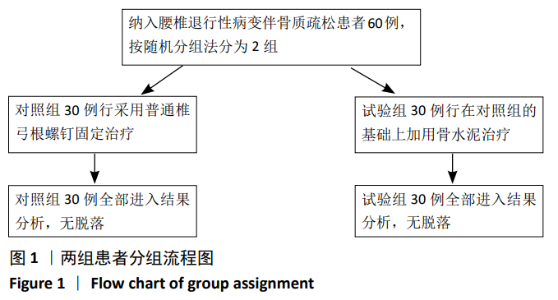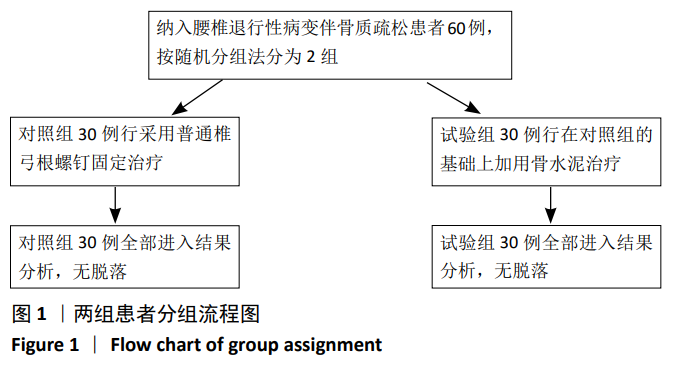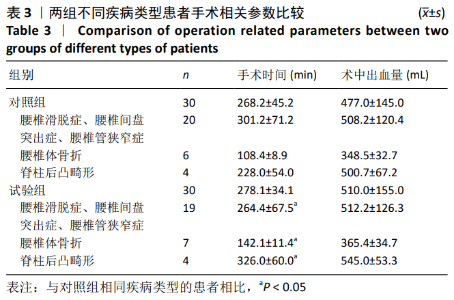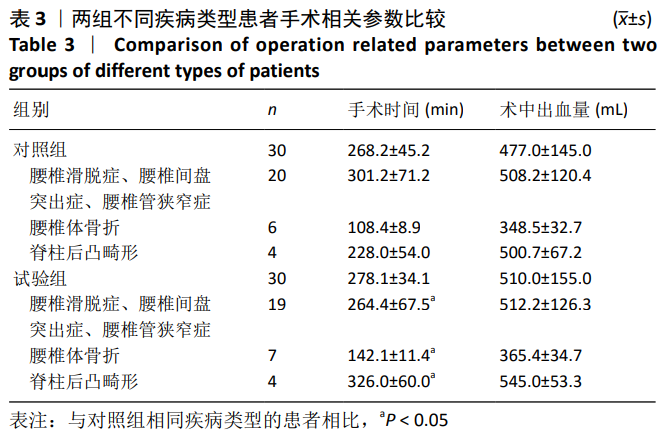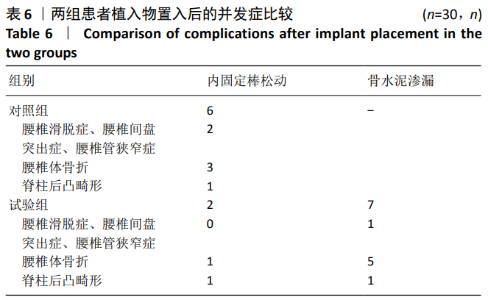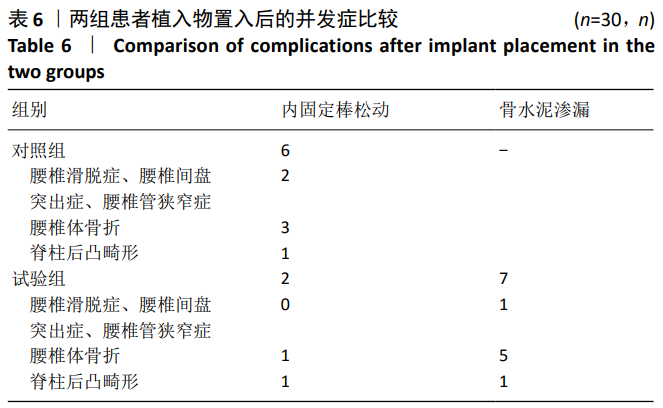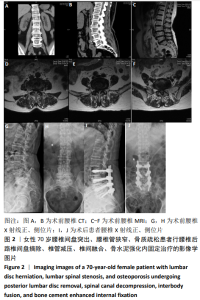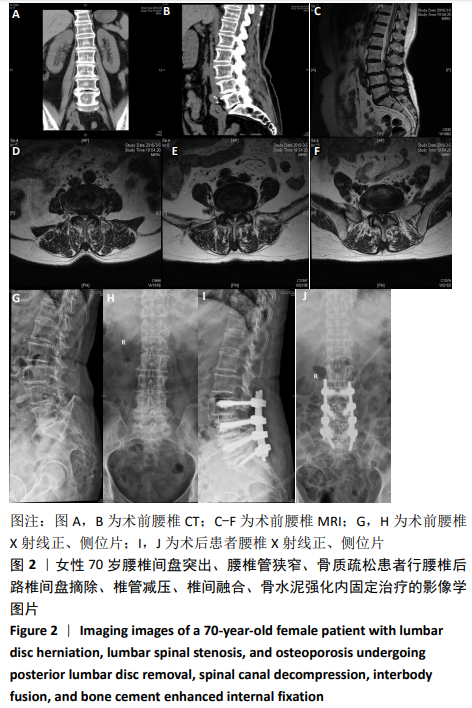Chinese Journal of Tissue Engineering Research ›› 2021, Vol. 25 ›› Issue (6): 878-883.doi: 10.3969/j.issn.2095-4344.2391
Previous Articles Next Articles
Bone cement pedicle screw fixation and fusion in the treatment of degenerative spinal disease with osteoporosis: one-year follow-up
Hou Guangyuan1, 2, Zhang Jixue2, Zhang Zhijun2, Meng Xianghui2, Duan Wen2, Gao Weilu1
- 1Department of Orthopedics, First Affiliated Hospital of Anhui Medical University, Hefei 230022, Anhui Province, China; 2Department of Orthopedics, Anhui Provincial Cancer Hospital, Hefei 230031, Anhui Province, China
-
Received:2020-03-02Revised:2020-03-06Accepted:2020-04-18Online:2021-02-28Published:2020-12-03 -
Contact:Gao Weilu, MD, Associate chief physician, Department of Orthopedics, First Affiliated Hospital of Anhui Medical University, Hefei 230022, Anhui Province, China -
About author:Hou Guangyuan, Master, Attending physician, Department of Orthopedics, First Affiliated Hospital of Anhui Medical University, Hefei 230022, Anhui Province, China; Department of Orthopedics, Anhui Provincial Cancer Hospital, Hefei 230031, Anhui Province, China -
Supported by:the National Natural Science Foundation of China (General Program), No. 81871785
CLC Number:
Cite this article
Hou Guangyuan, Zhang Jixue, Zhang Zhijun, Meng Xianghui, Duan Wen, Gao Weilu. Bone cement pedicle screw fixation and fusion in the treatment of degenerative spinal disease with osteoporosis: one-year follow-up[J]. Chinese Journal of Tissue Engineering Research, 2021, 25(6): 878-883.
share this article
Add to citation manager EndNote|Reference Manager|ProCite|BibTeX|RefWorks
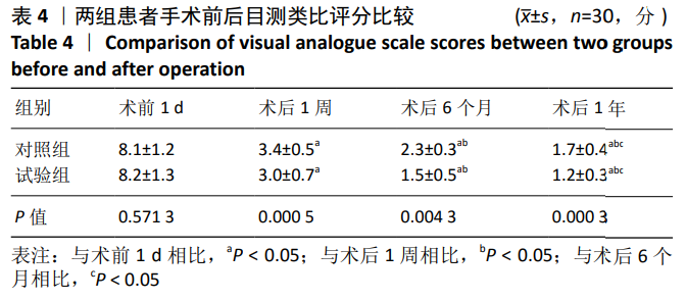
2.5 两组患者手术前后目测类比评分比较 见表4。 2组间比较:经统计学分析,试验组与对照组患者在术前1 d的目测类比评分差异无显著性意义(P > 0.05)。试验组术后1周、6个月及1年的目测类比评分均低于对照组,差异有显著性意义(P < 0.05)。 试验组及对照组的组内比较:2组患者术后1周、术后6个月及术后1年的目测类比评分与术前对比,差异有显著性意义(P < 0.05),说明术后1周、 6 个月及1年目测类比评分优于术前;术后6个月、1年与术后1周目测类比评分相比,经统计学分析,差异有显著性意义(P < 0.05),说明术后6个月及1年目测类比评分与术后1周相比目测类比评分有降低;术后1年与术后6个月的目测类比评分相比,通过统计分析,差异有显著性意义(P < 0.05),也证实术后1年的目测类比评分优于术后6个月,在长期治疗上有一定的作用。 "
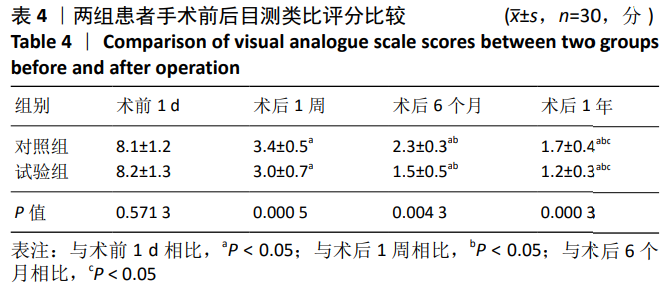
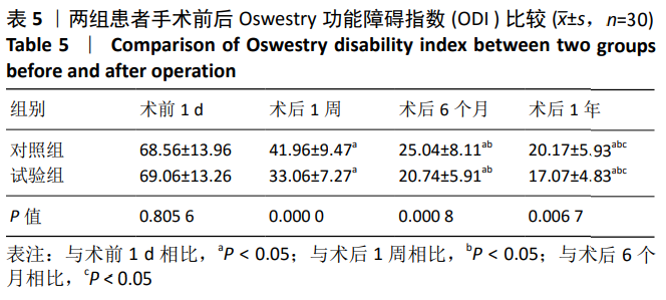
2.6 两组患者手术前后ODI比较 见表5。 2组间比较:经统计学分析,试验组与对照组患者在术前1d的ODI差异无显著性意义(P > 0.05);试验组术后1周、6个月及1年的ODI均低于对照组,差异有显著性意义(P < 0.05)。 试验组及对照组的组内比较:2组患者术后1周、6个月及1年的ODI与术前对比,差异有显著性意义(P < 0.05),说明术后1周、 6 个月及1年患者 ODI优于术前;术后6个月、1年与术后1周ODI相比,经统计学分析,差异有显著性意义(P < 0.05),说明术后6个月及1年ODI与术后1周相比ODI有所降低;术后1年与术后6个月的ODI相比,通过统计分析,差异有显著性意义(P < 0.05),也证实术后1年的ODI优于术后6个月,在长期治疗上有一定的作用。 "
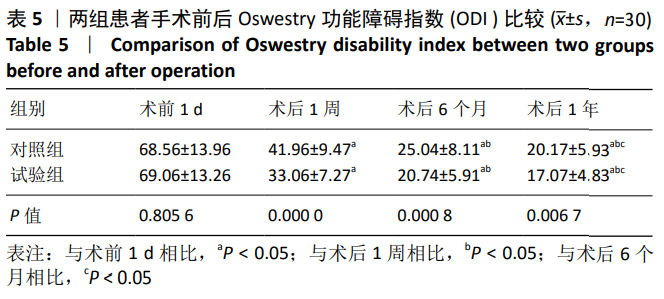
| [1] MASUDA K, AOTA Y, MUEHLEMAN C, et al. A novel rabbit model of mild, reproducible disc degeneration by an anulus needle puncture: correlation between the degree of disc injury and radiological and histological appearances of disc degeneration. Spine (Phila Pa 1976). 2005;30(1):5-14. [2] HANLEY EN JR, HERKOWITZ HN, KIRKPATRICK JS, et al. Debating the value of spine surgery. J Bone Joint Surg Am. 2010;92(5):1293-1304. [3] 郭文龙. 不同方式骨水泥强化椎弓根螺钉对骨质疏松椎体的生物力学实验研究[D]. 扬州:扬州大学, 2015. [4] SEELIGER C, SCHYSCHKA L, KRONBACH Z, et al. Signaling pathway STAT1 is strongly activated by IFN-β in the pathogenesis of osteoporosis. Eur J Med Res. 2015;20(1):1-8. [5] GUOXIN J, HUAN W. Unilateral C-1 posterior arch screws and C-2 laminar screws combined with a 1-side C1-2 pedicle screw system as salvage fixation for atlantoaxial instability. J Neurosurg Spine. 2015; 24(2):1-6. [6] 张震,未东兴.颈椎椎弓根螺钉置入内固定:影像学测量与临床应用[J].中国组织工程研究与临床康复, 2010,14(39):7378-7381. [7] RITZEL H, AMLING M, PÖSL M, et al. The Thickness of Human Vertebral Cortical Bone and Its Changes in Aging and Osteoporosis: A Histomorphometric Analysis of the Complete Spinal Column from Thirty-Seven Autopsy Specimens. J Bone Miner Res. 1997;12(1): 89-95. [8] PFLUGMACHER R, BORNEMANN R, KOCH EMW, et al. Comparative Findings of Balloon Kyphoplasty in Patients with Vertebral Fractures due to Osteoporosis, Metastases and Myeloma. Z Orthop Unfall . 2012; 150(2):198-204. [9] KAIMRAJH D, BARRETO A, LATTA LL, et al. Analysis of Pullout Strength and Pedicle Screw Loosening from Loading Rigid Rod Construct// 25th Southern Biomedical Engineering Conference 2009, 15 -17 May 2009, Miami, Florida, USA. Springer Berlin Heidelberg, 2009:145 -146. [10] FRANKEL BM, JONES T, WANG C. Segmental polymethylmethacrylate-augmented pedicle screw fixation in patients with bone softening caused by osteoporosis and metastatic tumor involvement: a clinical evaluation. Spine J. 2006;6(5):52S-53S. [11] LUBANSU A, MASUDI J, PIROTTE B, et al. Reduction of bone failure in osteoporotic spine arthrodesis by using of a fenestrated pedicle screw and cement injection. Surg Neurol. 2009;72(5):522-522. [12] 丁权,陈勇. 骨水泥强化椎弓根螺钉置入固定骨质疏松性腰椎滑脱:1年随访[J].中国组织工程研究,2015,19(48):7752-7757. [13] 殷刚,朱建国,杨雷,等.不同方式下骨水泥强化椎弓根螺钉固定手术治疗伴骨质疏松症腰椎退变性疾病的疗效对比[J].颈腰痛杂志,2018,39(4):412-415. [14] 殷渠东,田小武,郑祖根.骨质疏松患者椎弓根螺钉稳定性的随访[J].中国组织工程研究,2013,17(13):2346-2351. [15] 易早元. 经伤椎椎弓根植骨结合膨胀型椎弓根钉固定治疗老年性胸腰椎骨折[J]. 实用临床医药杂志, 2014, 18(19):124-126. [16] 高贵营,夏庆福,黄立军,等.椎弓根螺钉结合骨水泥椎体成形术对骨质疏松性胸腰椎骨折患者远期疗效的前瞻性研究[J].中国骨与关节杂志,2018,7(7):494-498. [17] KIM HS, KIM SW, JU CI, et al. Short segment fixation forthoracolumbar burst fracture accompanying osteopenia: acomparative study. J KOREAN NEUROSURG SOC. 2013;53(1):26-30. [18] 刘达, 张译, 蒋凯,等. 骨质疏松人工骨模块中膨胀式椎弓根螺钉与骨水泥强化螺钉稳定性的比较研究[J]. 重庆医科大学学报, 2015,40(2):176-180. [19] FUERDERER S, VONHOEGEN J, COENEN O, et al. In vitro comparison of the pullout strength of 3 anterior double-screw fixation techniques with different screw angulations. J Neurosurg Spine. 2011;14(3): 367-371. [20] ZEYNALOV R, AĞIR İ, AKGÜLLE AH, et al. The holding strength of cannulated screw supported with PMMA: a biomechanical study on sowbone. Eur J Orthop Surg Traumatol. 2015;25(5):955-960. [21] MOLDAVSKY M, SALLOUM K, BUCKLEN B, et al. In vitro biomechanical study of pedicle screw pull-out strength based on different screw path preparation techniques. Indian J Orthop. 2016; 50(2):177-182. [22] 吴剑维. 新型空心侧孔椎弓根螺钉的最佳设计和骨水泥椎体内最合理分布的研究[D]. 西安:第四军医大学, 2013. [23] RENNER SM, LIM TH, KIM WJ, et al. Augmentation of pedicle screw fixation strength using an injectable calcium phosphate cement as a function of injection timing and method. Spine. 2004;29(11): E212-E216. [24] MINGXUAN G, PING Z, YUN X, et al. Biomechanical performance of pedicle screw augmented with an injectable calcium phosphate cement: an in vivo study. J Med Biomech. 2009;27(4):123-127. [25] HAOLIN S, CHUN L, HUILING L, et al. A novel injectable calcium phosphate-based nanocomposite for the augmentation of cannulated pedicle-screw fixation. Int J Nanomed. 2017;4(12):3395-3406. [26] 罗旭, 李丹, 杨俊.磷酸钙与聚甲基丙烯酸甲酯制备复合型骨水泥的生物安全性[J]. 广东医学, 2016, 37(s2):22-27. [27] BIN Y. Preparation of calcium phosphate cement and polymethyl methacrylate for biological composite bone cements. Med Sci Monit. 2015;21:1162-1172. [28] CHO W, WU C, ZHENG X, et al. Is it safe to back out pedicle screws after augmentation with polymethyl methacrylate or calcium phosphate cement? A Biomechanical Study. J Spinal Disord Tech. 2011;24(4): 276-279. [29] 宓士军,高景泰,周广军,等.关于椎体成形术的并发症及预防[J].中国矫形外科杂志,2008,20(25):1189-1191. [30] 吕振木, 杨中华, 崔青,等. 小剂量骨水泥椎体成形术治疗骨质疏松伴椎体压缩性骨折[J]. 中国矫形外科杂志, 2010, 18(12): 1043-1044. [31] 吴子祥,雷伟,桑宏勋,等.新型“渐变孔”骨水泥锚固螺钉用于重度骨质疏松脊柱手术的生物力学及临床研究.第六届《中华骨科杂志》论坛论文集,2013. [32] 吴子祥, 樊勇, 雷伟,等. 膨胀式椎弓根螺钉结合骨水泥强化钉道在严重骨质疏松脊柱手术中的应用[J]. 中华创伤骨科杂志, 2011, 13(2):114-118. [33] 孙治国, 王浩, 赵喜滨,等. 骨水泥强化椎弓根螺钉在腰椎管狭窄伴骨质疏松椎体中的临床应用[J]. 中国医师杂志, 2014, 16(z2): 59-61. |
| [1] | Hu Kai, Qiao Xiaohong, Zhang Yonghong, Wang Dong, Qin Sihe. Treatment of displaced intra-articular calcaneal fractures with cannulated screws and plates: a meta-analysis of 15 randomized controlled trials [J]. Chinese Journal of Tissue Engineering Research, 2021, 25(9): 1465-1470. |
| [2] | Huang Dengcheng, Wang Zhike, Cao Xuewei. Comparison of the short-term efficacy of extracorporeal shock wave therapy for middle-aged and elderly knee osteoarthritis: a meta-analysis [J]. Chinese Journal of Tissue Engineering Research, 2021, 25(9): 1471-1476. |
| [3] | Xu Feng, Kang Hui, Wei Tanjun, Xi Jintao. Biomechanical analysis of different fixation methods of pedicle screws for thoracolumbar fracture [J]. Chinese Journal of Tissue Engineering Research, 2021, 25(9): 1313-1317. |
| [4] | Jiang Yong, Luo Yi, Ding Yongli, Zhou Yong, Min Li, Tang Fan, Zhang Wenli, Duan Hong, Tu Chongqi. Von Mises stress on the influence of pelvic stability by precise sacral resection and clinical validation [J]. Chinese Journal of Tissue Engineering Research, 2021, 25(9): 1318-1323. |
| [5] | Zhang Tongtong, Wang Zhonghua, Wen Jie, Song Yuxin, Liu Lin. Application of three-dimensional printing model in surgical resection and reconstruction of cervical tumor [J]. Chinese Journal of Tissue Engineering Research, 2021, 25(9): 1335-1339. |
| [6] | Zhang Yu, Tian Shaoqi, Zeng Guobo, Hu Chuan. Risk factors for myocardial infarction following primary total joint arthroplasty [J]. Chinese Journal of Tissue Engineering Research, 2021, 25(9): 1340-1345. |
| [7] | Wei Wei, Li Jian, Huang Linhai, Lan Mindong, Lu Xianwei, Huang Shaodong. Factors affecting fall fear in the first movement of elderly patients after total knee or hip arthroplasty [J]. Chinese Journal of Tissue Engineering Research, 2021, 25(9): 1351-1355. |
| [8] | Wang Jinjun, Deng Zengfa, Liu Kang, He Zhiyong, Yu Xinping, Liang Jianji, Li Chen, Guo Zhouyang. Hemostatic effect and safety of intravenous drip of tranexamic acid combined with topical application of cocktail containing tranexamic acid in total knee arthroplasty [J]. Chinese Journal of Tissue Engineering Research, 2021, 25(9): 1356-1361. |
| [9] | Xiao Guoqing, Liu Xuanze, Yan Yuhao, Zhong Xihong. Influencing factors of knee flexion limitation after total knee arthroplasty with posterior stabilized prostheses [J]. Chinese Journal of Tissue Engineering Research, 2021, 25(9): 1362-1367. |
| [10] | Huang Zexiao, Yang Mei, Lin Shiwei, He Heyu. Correlation between the level of serum n-3 polyunsaturated fatty acids and quadriceps weakness in the early stage after total knee arthroplasty [J]. Chinese Journal of Tissue Engineering Research, 2021, 25(9): 1375-1380. |
| [11] | Zhang Chong, Liu Zhiang, Yao Shuaihui, Gao Junsheng, Jiang Yan, Zhang Lu. Safety and effectiveness of topical application of tranexamic acid to reduce drainage of elderly femoral neck fractures after total hip arthroplasty [J]. Chinese Journal of Tissue Engineering Research, 2021, 25(9): 1381-1386. |
| [12] | Yao Rubin, Wang Shiyong, Yang Kaishun. Minimally invasive transforaminal lumbar interbody fusion for treatment of single-segment lumbar spinal stenosis improves lumbar-pelvic balance [J]. Chinese Journal of Tissue Engineering Research, 2021, 25(9): 1387-1392. |
| [13] | Wang Haiying, Lü Bing, Li Hui, Wang Shunyi. Posterior lumbar interbody fusion for degenerative lumbar spondylolisthesis: prediction of functional prognosis of patients based on spinopelvic parameters [J]. Chinese Journal of Tissue Engineering Research, 2021, 25(9): 1393-1397. |
| [14] | Lü Zhen, Bai Jinzhu. A prospective study on the application of staged lumbar motion chain rehabilitation based on McKenzie’s technique after lumbar percutaneous transforaminal endoscopic discectomy [J]. Chinese Journal of Tissue Engineering Research, 2021, 25(9): 1398-1403. |
| [15] | Chen Xinmin, Li Wenbiao, Xiong Kaikai, Xiong Xiaoyan, Zheng Liqin, Li Musheng, Zheng Yongze, Lin Ziling. Type A3.3 femoral intertrochanteric fracture with augmented proximal femoral nail anti-rotation in the elderly: finite element analysis of the optimal amount of bone cement [J]. Chinese Journal of Tissue Engineering Research, 2021, 25(9): 1404-1409. |
| Viewed | ||||||
|
Full text |
|
|||||
|
Abstract |
|
|||||
